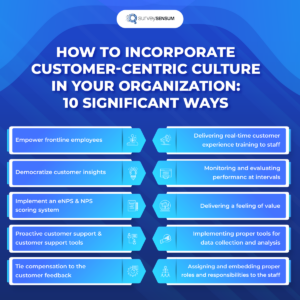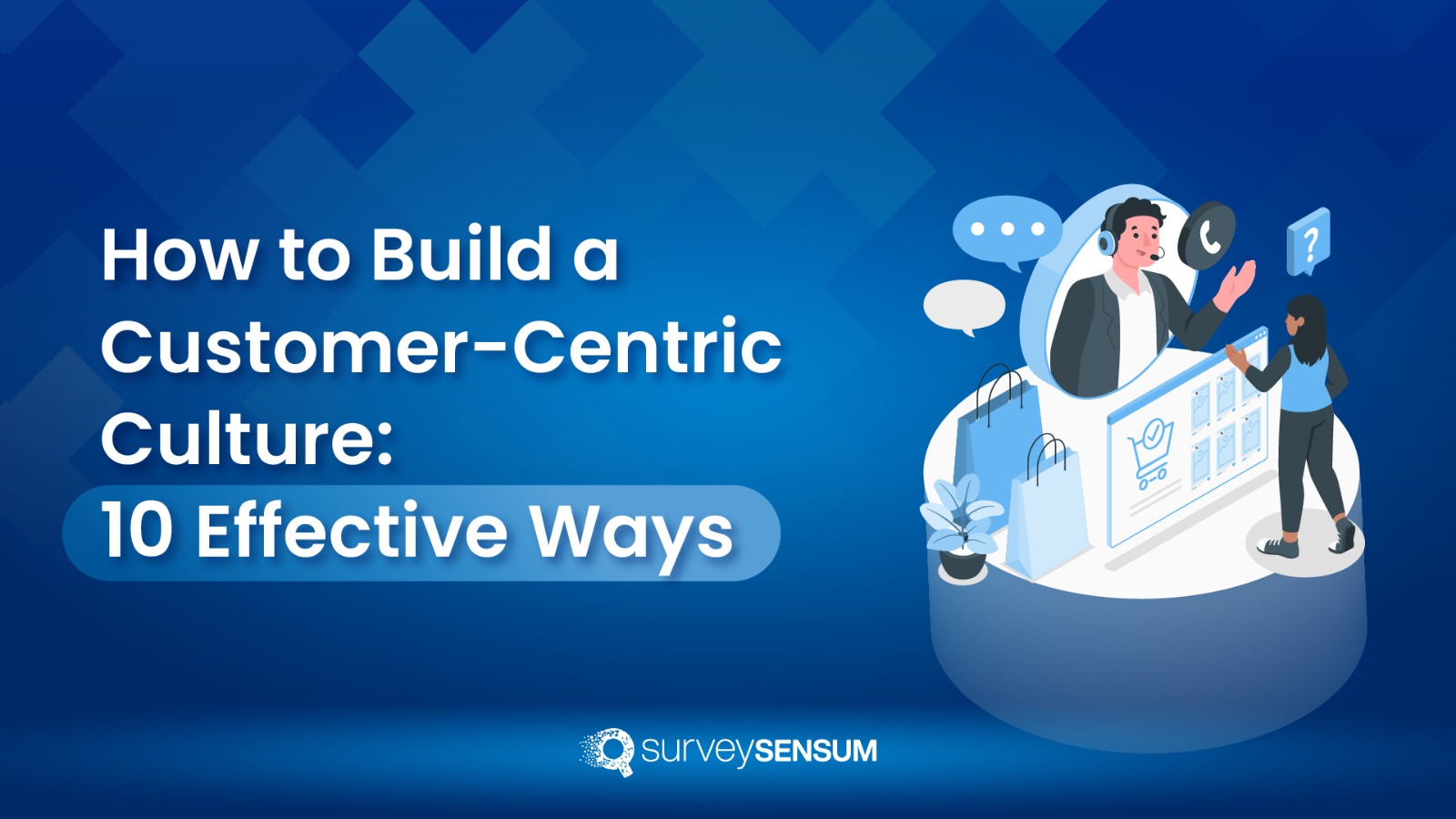

Data-driven decisionsIn today’s business world, customers hold the power to make or break a company’s success. With the rise of social media and online reviews, customers have more ways than ever to voice their opinions and influence others.
In this consumer-friendly environment, building a customer-centric culture is essential to success.
So, what is Customer-Centric Culture?
A customer-centric approach is a strategic way of doing business that puts the customer at the center of everything you do. It requires a fundamental shift in mindset, where the customer’s needs and preferences are the driving force behind all decision-making.
It is the art of delivering exceptional customer care and assistance in a way that enables companies to consider the customer as the central point of their business.
Importance & Benefits of a Customer-Centric Approach
As we witness a rapid and aggressive digital transformation, businesses realize the importance of a customer-centric approach. Consumers are becoming more selective, responsive, and observant when they deal with companies and businesses, and they expect a consistent experience during and after their shopping or purchase.
Implementing a customer-centric culture in the organization can
- Help generate more business and revenue
- Promote value and value addition to your services
- Reduce employee churn
- Create a large loyal customer base
- Improve operational efficiency
- Build reliability and trust in customers
By putting the customer at the center of your business strategy, you can ensure that all departments and processes work together to deliver a seamless experience to the customer.
How to Incorporate Customer-Centric Culture in your Organization: 10 Significant Ways
Here are the ten significant ways to incorporate a customer-centric culture in your organization. By following these tips, you’ll be able to create a culture that puts your customers at the center of everything you do, which will ultimately lead to increased customer satisfaction, loyalty, and profitability.

So, let’s dive in and learn how to make your business more customer-centric.
1. Empower frontline employees
To ensure that customers receive immediate support and care, it is important to empower frontline employees. This means delegating the necessary power, knowledge, and ability to make the right decisions on time instead of always escalating concerns to the next-level team or manager.
To achieve this, companies should provide ways for employees to build customer relationships and interact with them directly at every touchpoint. In addition, mentorship program and co-creation can help embed a culture of growth and customer-centricity within the company.
Co-creating strategies can also encourage employees to become passionate about the company and promote it positively.
2. Democratize customer insights
In a customer-centric culture, it is important to share customer insights and sales analytics with employees. By doing so, they can understand their responsibilities and focus better on building rapport and relationships with customers. This is more effective than keeping the data secure in the manager’s custody.
To create a customer-centric culture, organizations should regularly discuss and evaluate real-time customer experiences with new and old employees. This can help identify areas for improvement and highlights successful practices when dealing with customers.
In addition, employee management platforms should train employees in customer-handling strategies and policies to ensure that they understand their role and what is expected of them in creating a positive customer experience.
3. Implement an eNPS & NPS scoring system
Implementing an eNPS (Employee Net Promoter Score) and NPS (Net Promoter Score) system can help organizations in building a customer-centric culture by:
- Understanding employee and customer satisfaction: Regularly conducting eNPS and NPS surveys can help organizations understand the level of satisfaction their employees and customers have with the organization. This feedback can be used to identify areas where improvements are needed to better meet their needs and expectations.
- Prioritizing changes for improvement: By analyzing the feedback and identifying areas for improvement, organizations can prioritize the changes that would have the most impact on improving customer satisfaction and employee satisfaction. This can help in creating a more customer-centric culture, where employees are empowered to focus on delivering better customer experiences.
- Tracking progress over time: The eNPS and NPS scores can be used as benchmarks to track the organization’s progress in building a customer-centric culture over time. Regularly reviewing the scores and analyzing the feedback can help organizations ensure that they are continuously improving and evolving to meet the needs of their employees and customers.
Overall, implementing an eNPS and NPS scoring system is an effective way to build a culture that is centered around the needs and expectations of employees and customers, which is crucial for achieving long-term success in today’s highly competitive business environment.
4. Proactive customer support & customer support tools
By offering proactive support, an organization demonstrates that it values its customers’ satisfaction and is committed to addressing their needs and concerns quickly.
And when customer support teams have access to the right tools and resources, they can quickly identify and resolve issues before they become major problems. Pairing these tools with an AI detector ensures that automated replies or content suggestions stay humanlike and customer-relatable. This not only helps your employees to find solutions immediately but also allows them to resolve issues quickly without the need for escalation to higher-level managers.
This helps to prevent customer frustration and shows that the organization is proactive in its approach to customer service.
5. Tie compensation to customer feedback
When compensation is tied to customer feedback, employees become more aware of their impact on customer satisfaction and are incentivized to improve their performance in ways that positively impact the customer experience.
Here are some specific ways that tying compensation to customer feedback can help build a customer-centric culture:
-
- It encourages employees to focus on the customer
- It creates a sense of accountability, where employees take ownership of their work and go above and beyond to ensure customer satisfaction.
- It fosters a culture of continuous improvement, where employees are incentivized to seek out ways to improve their performance and the customer experience.
- It increases employee commitment, as employees feel their work is meaningful and that their performance is tied to customer satisfaction.
- It improves customer satisfaction, leading to increased business success.
6. Delivering real-time customer experience training to staff
Delivering real-time customer experience training to staff provides employees with the knowledge and skills they need to provide exceptional service to customers.
When employees understand the importance of providing a positive experience to customers, they are more likely to make an effort to meet their needs and exceed their expectations.
How does it help in building a customer-centric culture?
- It helps managers understand the competency, skill sets, and efficiency of the employees involved in direct customer handling.
- Give gives employees adequate customer data and insights to learn, evaluate, and improvise a plan of action when dealing with customers in real-time.
- It enables employees to quickly adjust their behavior and actions to better meet customer needs and expectations.
- It holds employees accountable for their performance, encouraging them to take ownership of their actions and responsibility for customer experience.
- It empowers employees to make decisions on the spot, boosting their confidence in solving customer problems and providing exceptional service without the need for supervisor approval.
In summary, delivering real-time customer experience training to staff is a crucial step in building a customer-centric culture.
7. Monitoring and evaluating performance at intervals
Set up KPIs to gauge customer-centricity from bottom-level employees to top-level managers to ensure that customer-centricity is a top priority in an organization. This helps to establish a culture that puts the customer first and ensures that everyone in the organization is working towards delivering an exceptional customer experience.
But how can you do it?
- Encourage employees to do self-evaluation. It enables them to learn from mistakes, restructure their modus operandi, and improve their skills and capabilities.
- Monitor and evaluate performance regularly to ensure the proper practice of customer-centric culture in the organization.
- Continuously track and analyze negative reviews, order returns, cancellations, and complaints.
- Celebrate positive feedback, learn from negative feedback, and identify ways to improve customer experience.
By following this, businesses can ensure that customer-centricity is a top priority across all levels of the organization. It allows employees to improve their skills and capabilities, continuously monitor performance, and make necessary improvements to deliver excellent customer experience. It also allows line managers to understand where their team is performing well and where it is performing poorly. If poor performance persists, they may then need to look to get help either informally, or formally through a structured workshop or similar.
8. Delivering a feeling of value
One of the best practices in creating a customer-centric culture is to make customers feel valued and important. This can be achieved by engaging with them honestly, with integrity, mutual trust, and respect. It is crucial to remember that the feeling of value must come from the customer’s perspective rather than what the business thinks it delivers.
Personalizing services, actively listening to them, closing the loop, thanking them, and offering proactive support are effective ways to make customers feel valued and important. These practices show that the business cares about customers’ needs and wants and is committed to delivering a positive customer experience.
In the end, building a customer-centric culture requires a deep understanding of the customer’s needs and wants and a commitment to delivering a positive customer experience.
9. Implementing proper tools for data collection and analysis
Implementing proper tools and technologies for collecting and analyzing customer data is essential for building a customer-centric culture, as it allows businesses to better understand their customers’ needs and preferences.
By continuously tracking and monitoring important metrics such as NPS scores, customer feedback, and behavior, businesses can gain insights into what customers like and dislike about their products or services.
This data can help businesses make data-driven decisions about how to improve their products and services to better meet customer needs and expectations. And by making improvements based on customer feedback and behavior, businesses can show that they are listening to their customers and prioritizing their needs.
Overall, using customer data to drive business decisions is a crucial element of building a customer-centric culture. It allows businesses to create a better customer experience, which can lead to increased customer loyalty and advocacy.
10. Assigning and embedding proper roles and responsibilities to the staff
Assigning and embedding proper roles and responsibilities for staff is essential to reduce unnecessary chaos and confusion. This enables a business to build a visionary team that can effectively handle its customers.
When employees know their roles and responsibilities, it increases operational efficiency, employee productivity, and individual performance.
In a customer-centric culture, it is important to design and embed individual accountabilities and roles that transform employees into customer ambassadors. This means that every employee is responsible for ensuring that customers have a positive experience with the business.
By doing so, employees become invested in the success of the business and are more likely to go above and beyond to provide excellent customer service.
How to gauge the success of your customer-centric culture?
After all the long theories and explanations, the final question is —
‘How do you gauge the success of your customer-centric culture? Or how do you measure your success as a customer-centric organization?’
Success metrics may differ from organization to organization depending on its values, policies, and strategies. Given below are some factors that can help you identify and gauge the success or failure of a customer-centric culture.
# Employee churn: – Passionate and high-performing employees do not leave your organization. They accomplish great positions and growth within the organization. So, if you have lower employee churn/ turnover, your employees are happy and motivated, which will reflect in the service.
# Customer churn: – It is easier to attract customers but difficult to maintain. A low churn rate of your existing customers means you have a great customer-centric culture. It also means you have great people to take care of your customers.
# NPS & eNPS: – Net Promoter Score and Employer Net Promoter Score are two metrics that help you analyze the organization’s performance and attitude towards customers and employees. You have great customer loyalty when more and more customers recommend your brand and company. You have great organizational culture when more and more of your employees recommend it as a great workplace.
# CLV: – Customer Lifetime Value (CLV) helps you understand the longevity of your clients. It directly implies the duration of their business with you – from the first purchase to the last – as a customer.
Setting up Responsibility Levels for a Customer-Centric Culture
Transforming your business into a customer-centric culture takes time, patience, and great effort. It requires a collaborative effort across the organization, starting from the top down. Executive leaders, frontline managers, supervisors, HR, marketing, sales, customer service, IT, and all other team members must work together towards a common goal.
Every employee has a unique role to play in becoming customer-centric. Each person is responsible for the organization’s success in achieving this goal.
To establish responsibility levels for a customer-centric culture, consider the following steps:
- Define what customer-centric means
- Identify key stakeholders
- Establish responsibility levels
- Set clear expectations
- Provide training and support
- Monitor and measure progress
By following these steps, you can create a positive customer experience and transform your business into a customer-centric culture.
Conclusion
A customer-centric culture is not a one-time effort; it requires ongoing maintenance and dedication to sustain it. Without proper maintenance, it may fade away. It’s crucial to have stringent long-term policies and strategies to maintain a customer-centric culture.
To ensure the longevity of your customer-centric culture, you should continuously monitor its effectiveness, track down issues, and resolve them promptly. Implementing continuous improvement plans, offering training and support whenever necessary, and maintaining transparent communication channels are all crucial to keep the customer-centric culture alive in your organization.
By prioritizing customer needs and satisfaction and aligning business strategies with customer needs, you can establish a strong customer-centric culture that will help your organization succeed in the long run.
Want to get started with SurveySensum?
FAQ (Frequently asked questions)
To create a customer-centric culture, an organization must prioritize customer needs and satisfaction by restructuring policies, strategies, and attitudes toward employees and customers. This includes providing continuous training and mentoring to employees, innovative tools and technologies to support customers, and empowering employees to make decisions that benefit customers.
A customer-centric culture is important because it prioritizes the needs and satisfaction of customers. By aligning business strategies with customer needs, organizations can build long-lasting customer relationships, increase customer loyalty, and drive business growth.
The four steps to creating an active customer-centric culture are:
- Understanding customer needs and expectations
- Aligning business strategies with customer needs
- Empowering employees to prioritize customer satisfaction
- Continuously monitoring and improving the customer experience.
- Solution-based approach
- Keeping the customer as the central point of everything
- Frontline employee empowerment
- Transparency, consistency, and a plan for continuous improvement
Customer-centric behaviors prioritize the needs and satisfaction of customers. Some examples of customer-centric behaviors include active listening, empathy, responsiveness, problem-solving, and going above and beyond to meet customer needs.
Customer culture is an organizational strategy that allows the organization to care for its customers and provide immediate solutions and assistance to customers at times of need.















